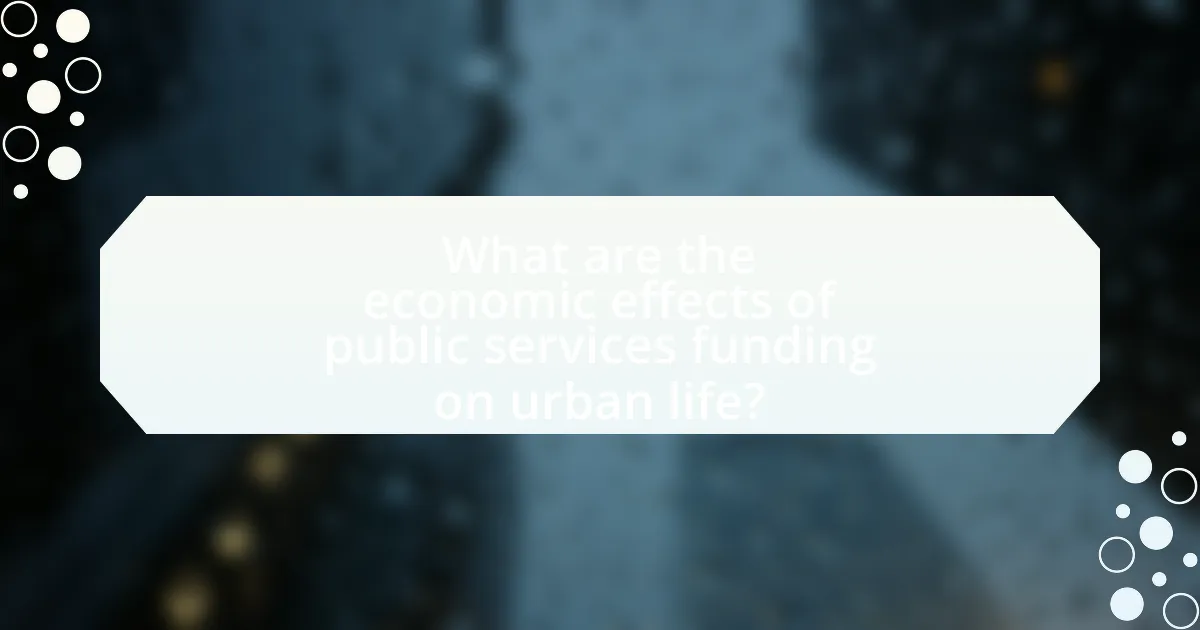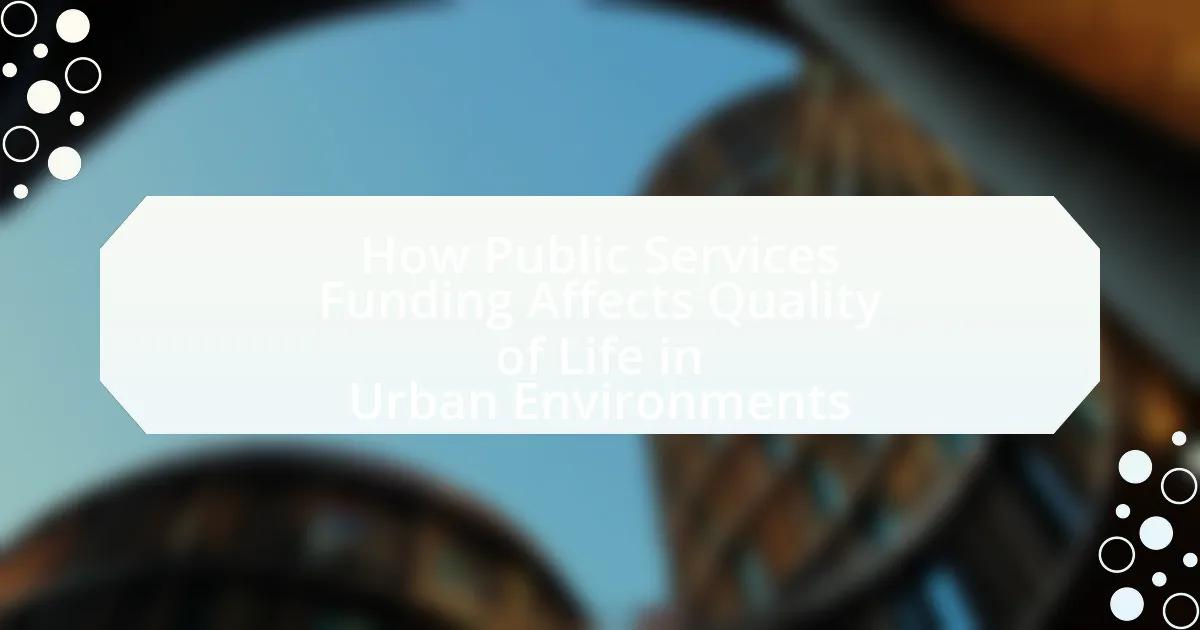Public services funding is a critical determinant of quality of life in urban environments, influencing essential services such as healthcare, education, transportation, public safety, and sanitation. Higher funding levels correlate with improved health outcomes, lower crime rates, and enhanced educational attainment, thereby fostering community well-being and economic stability. The article examines the impact of public services funding on urban living conditions, exploring key areas such as transportation, healthcare, and education, while also addressing the consequences of underfunding and the importance of equitable resource distribution. Additionally, it discusses the relationship between funding models and service delivery, highlighting best practices for optimizing public services funding to enhance urban quality of life.

How does public services funding impact quality of life in urban environments?
Public services funding significantly impacts quality of life in urban environments by determining the availability and quality of essential services such as healthcare, education, public safety, and infrastructure. For instance, cities with higher public services funding often report better health outcomes, lower crime rates, and improved educational attainment. According to a study by the Urban Institute, increased investment in public services correlates with enhanced community well-being and economic stability, demonstrating that adequate funding leads to more accessible and effective services that directly benefit residents.
What are the key public services that influence urban quality of life?
Key public services that influence urban quality of life include transportation, healthcare, education, public safety, and sanitation. Transportation systems, such as public transit, enhance accessibility and reduce congestion, directly impacting residents’ mobility and time efficiency. Healthcare services ensure community health and well-being, with studies indicating that access to quality healthcare correlates with lower mortality rates and improved life expectancy. Education services provide essential skills and knowledge, contributing to economic opportunities and social mobility. Public safety services, including police and fire departments, create secure environments, which are crucial for community trust and stability. Lastly, sanitation services maintain cleanliness and public health, with effective waste management linked to reduced disease transmission and improved living conditions.
How do transportation services affect urban living conditions?
Transportation services significantly impact urban living conditions by enhancing accessibility, reducing travel time, and improving overall mobility. Efficient transportation systems facilitate the movement of people and goods, which can lead to economic growth and increased job opportunities. For instance, cities with well-developed public transit networks, such as New York and Tokyo, experience higher levels of economic activity due to easier access to employment centers. Additionally, studies show that improved transportation services can lead to better air quality and reduced traffic congestion, contributing to healthier urban environments. According to the American Public Transportation Association, every $1 invested in public transportation generates approximately $4 in economic returns, highlighting the direct correlation between transportation services and urban living conditions.
What role does healthcare funding play in urban quality of life?
Healthcare funding significantly impacts urban quality of life by ensuring access to essential medical services and promoting public health. Adequate funding leads to improved healthcare infrastructure, which reduces wait times and enhances the quality of care provided to residents. For instance, cities with higher healthcare expenditures often report lower rates of preventable diseases and better overall health outcomes, as evidenced by a study published in the American Journal of Public Health, which found that increased healthcare spending correlates with improved life expectancy and reduced mortality rates in urban populations. Thus, effective healthcare funding is crucial for fostering a healthier urban environment and enhancing the overall quality of life for residents.
How does education funding contribute to urban community well-being?
Education funding significantly enhances urban community well-being by improving access to quality education, which leads to better economic opportunities and social outcomes. Increased funding allows schools to hire qualified teachers, provide essential resources, and implement programs that support student development. For instance, research from the National Bureau of Economic Research indicates that increased per-pupil spending is associated with higher graduation rates and improved long-term earnings for students. This, in turn, contributes to reduced poverty levels and lower crime rates in urban areas, fostering a healthier and more stable community environment.
Why is adequate funding for public services essential in urban areas?
Adequate funding for public services is essential in urban areas because it directly impacts the quality of life for residents. Sufficient financial resources ensure the provision of critical services such as healthcare, education, transportation, and public safety, which are vital for the well-being and development of urban populations. For instance, a study by the Urban Institute found that cities with higher public service funding experience lower crime rates and improved health outcomes, demonstrating a clear correlation between funding levels and community safety and health. Additionally, effective public transportation systems, funded adequately, reduce traffic congestion and pollution, enhancing overall urban living conditions.
What are the consequences of underfunded public services in cities?
Underfunded public services in cities lead to deteriorating infrastructure, reduced access to essential services, and increased social inequality. For instance, inadequate funding for public transportation results in unreliable services, making it difficult for residents to commute to work or access healthcare. Additionally, underfunded education systems often struggle to provide quality learning environments, which can hinder students’ academic performance and future opportunities. A study by the National League of Cities found that cities with lower public service funding experience higher crime rates, as community safety initiatives are compromised. Furthermore, public health services may become overwhelmed, leading to poorer health outcomes for residents, particularly in marginalized communities. These consequences collectively diminish the overall quality of life in urban environments.
How does public service funding correlate with urban crime rates?
Public service funding is inversely correlated with urban crime rates; higher funding typically leads to lower crime rates. Research indicates that increased investment in public services such as education, healthcare, and community programs can reduce crime by addressing root causes like poverty and lack of opportunity. For instance, a study by the National Institute of Justice found that cities that allocated more resources to youth programs saw a significant decrease in juvenile crime rates. Additionally, the Brennan Center for Justice reported that cities with robust public safety funding experienced lower violent crime rates, demonstrating that effective allocation of resources can enhance community safety and quality of life.
How do different funding models affect public services in urban settings?
Different funding models significantly impact the quality and availability of public services in urban settings. For instance, a tax-based funding model typically ensures a more stable and predictable revenue stream, allowing for consistent service delivery, such as public transportation and waste management. In contrast, a grant-based funding model may lead to fluctuations in service quality, as funding can be contingent on specific projects or initiatives, which may not address ongoing community needs. Research by the Urban Institute indicates that cities relying on diverse funding sources, including public-private partnerships, often experience enhanced service innovation and efficiency, as these models can leverage additional resources and expertise. Thus, the choice of funding model directly influences the effectiveness and sustainability of public services in urban areas.
What are the advantages and disadvantages of centralized funding?
Centralized funding offers the advantage of streamlined resource allocation, allowing for uniform distribution of financial resources across various public services, which can enhance efficiency and reduce administrative costs. This approach can lead to improved service quality in urban environments, as funds can be directed to areas of greatest need based on comprehensive assessments.
However, centralized funding also has disadvantages, including potential bureaucratic inefficiencies and a lack of responsiveness to local needs. When funding decisions are made at a higher level, they may not adequately reflect the unique challenges faced by specific urban communities, leading to misallocation of resources and dissatisfaction among residents.
How does decentralized funding impact service delivery in urban areas?
Decentralized funding enhances service delivery in urban areas by allowing local governments to allocate resources based on specific community needs. This localized approach leads to more responsive and tailored services, as municipalities can prioritize projects that directly address the unique challenges faced by their residents. For instance, a study by the World Bank in 2020 found that cities with decentralized funding mechanisms reported a 15% increase in citizen satisfaction with public services, as local authorities were better equipped to address issues such as waste management and public transportation. This evidence demonstrates that decentralized funding not only improves the efficiency of service delivery but also fosters greater community engagement and accountability in urban governance.

What are the social implications of public services funding in urban environments?
Public services funding in urban environments significantly influences social equity and community well-being. Adequate funding ensures access to essential services such as education, healthcare, and public safety, which are critical for fostering a healthy and productive population. For instance, a study by the Urban Institute found that cities with higher public service investment experience lower crime rates and improved educational outcomes, demonstrating a direct correlation between funding levels and social stability. Furthermore, equitable distribution of resources can reduce disparities among different socioeconomic groups, promoting social cohesion and reducing tensions within diverse urban populations.
How does public services funding affect social equity in cities?
Public services funding significantly impacts social equity in cities by determining the availability and quality of essential services such as education, healthcare, and public safety. When funding is allocated equitably, marginalized communities gain access to better resources, which can lead to improved outcomes in health, education, and economic opportunities. For instance, a study by the Urban Institute found that cities with more equitable public service funding saw a reduction in income inequality and improved social mobility. Conversely, inadequate funding often exacerbates disparities, leaving low-income neighborhoods with under-resourced schools and limited healthcare access, which perpetuates cycles of poverty and inequality.
What disparities exist in public service funding across different urban neighborhoods?
Disparities in public service funding across different urban neighborhoods often manifest in unequal access to essential services such as education, healthcare, and public safety. For instance, neighborhoods with higher socioeconomic status typically receive more funding for schools, resulting in better educational resources and facilities, while lower-income neighborhoods face underfunded schools, leading to poorer educational outcomes. According to a report by the National Center for Education Statistics, schools in affluent areas can receive up to 50% more funding per student compared to those in economically disadvantaged areas. Additionally, healthcare services are often concentrated in wealthier neighborhoods, leaving low-income areas with fewer clinics and hospitals, which contributes to significant health disparities. A study published in the American Journal of Public Health found that residents in low-income neighborhoods have a higher incidence of chronic diseases due to limited access to healthcare resources. Public safety funding also varies, with affluent neighborhoods often benefiting from more police presence and community programs, while poorer neighborhoods may experience higher crime rates and less effective law enforcement. These funding disparities directly impact the quality of life for residents in urban environments, perpetuating cycles of inequality.
How can equitable funding improve community relations in urban areas?
Equitable funding can improve community relations in urban areas by ensuring that resources are distributed fairly among diverse populations, fostering trust and collaboration. When funding is allocated based on need rather than political influence or socioeconomic status, marginalized communities receive essential services such as education, healthcare, and public safety, which enhances their quality of life. For instance, a study by the Urban Institute found that equitable funding in public schools leads to better educational outcomes for low-income students, thereby promoting social cohesion and reducing disparities. This approach not only addresses immediate community needs but also empowers residents to engage in local governance, ultimately strengthening community ties and enhancing overall urban stability.
What is the relationship between public services funding and community engagement?
Public services funding directly influences community engagement by providing the necessary resources for programs that foster participation and collaboration among residents. When public services are adequately funded, communities can access better facilities, educational programs, and outreach initiatives, which encourage residents to become more involved in local governance and civic activities. For instance, a study by the Urban Institute found that increased funding for community programs led to a 30% rise in volunteer participation rates, demonstrating a clear link between financial investment in public services and enhanced community involvement.
How does funding influence citizen participation in urban governance?
Funding significantly influences citizen participation in urban governance by determining the resources available for public engagement initiatives. When adequate funding is allocated to community programs, outreach efforts, and participatory budgeting, it enhances opportunities for citizens to engage in decision-making processes. For instance, a study by the Urban Institute found that cities with dedicated funding for civic engagement saw a 30% increase in citizen participation rates compared to those without such funding. This correlation indicates that financial investment in public services not only facilitates better communication between government and citizens but also empowers communities to actively contribute to governance, thereby improving overall quality of life in urban environments.
What role do public services play in fostering community identity?
Public services play a crucial role in fostering community identity by providing essential resources and opportunities for social interaction among residents. These services, such as parks, libraries, and community centers, create shared spaces where individuals can engage in activities that promote a sense of belonging and collective identity. For instance, a study by the Urban Institute found that access to well-maintained public parks significantly enhances community cohesion, as they serve as venues for events and gatherings that strengthen social ties. Additionally, public services often reflect the cultural values and needs of the community, further solidifying a shared identity among residents.
How does public services funding impact mental health in urban populations?
Public services funding significantly impacts mental health in urban populations by determining the availability and quality of mental health resources. Adequate funding leads to improved access to mental health services, including counseling, crisis intervention, and community support programs, which are essential for addressing the high rates of mental health issues in urban areas. For instance, a study published in the American Journal of Public Health found that cities with higher public health funding reported lower rates of depression and anxiety among residents. Conversely, insufficient funding can result in long wait times for services, reduced program availability, and increased stigma around seeking help, exacerbating mental health challenges. Thus, the level of public services funding directly correlates with the mental well-being of urban populations.
What services are most critical for supporting mental health in cities?
Mental health services critical for supporting mental health in cities include accessible counseling and therapy, crisis intervention services, community support programs, and mental health education initiatives. Accessible counseling and therapy provide individuals with professional support, which is essential for addressing mental health issues; studies show that areas with higher access to mental health professionals report better overall mental health outcomes. Crisis intervention services, such as hotlines and mobile crisis teams, offer immediate assistance during emergencies, reducing the risk of harm and promoting safety. Community support programs foster social connections and reduce isolation, which are vital for mental well-being; research indicates that social support networks significantly improve mental health resilience. Lastly, mental health education initiatives raise awareness and reduce stigma, encouraging individuals to seek help; evidence suggests that informed communities are more likely to engage in preventive mental health practices.
How can improved funding for public services enhance mental well-being?
Improved funding for public services can enhance mental well-being by increasing access to mental health resources, recreational facilities, and community support programs. When public services receive adequate funding, they can provide essential mental health services, such as counseling and therapy, which are crucial for individuals experiencing mental health issues. For instance, a study by the World Health Organization found that increased investment in mental health services leads to better health outcomes and reduced stigma associated with mental illness. Additionally, well-funded recreational facilities promote physical activity and social interaction, both of which are linked to improved mental health. Furthermore, community support programs funded by public services can foster social connections and reduce feelings of isolation, contributing positively to overall mental well-being.

What are the economic effects of public services funding on urban life?
Public services funding significantly impacts urban life by enhancing economic stability and growth. Increased funding for public services such as education, healthcare, and transportation leads to improved infrastructure and workforce productivity. For instance, a study by the Urban Institute found that cities investing in public services experience higher job creation rates and increased property values, contributing to a more robust local economy. Additionally, effective public services reduce inequality by providing essential resources to underserved communities, fostering a more equitable economic environment.
How does public services funding influence local economic development?
Public services funding significantly influences local economic development by providing essential infrastructure and services that attract businesses and enhance community well-being. For instance, well-funded public services such as transportation, education, and healthcare create a conducive environment for economic activities, leading to job creation and increased investment. Research indicates that municipalities with higher public service expenditures experience faster economic growth; a study by the National Bureau of Economic Research found that every 1% increase in public service funding correlates with a 0.5% increase in local GDP. This demonstrates that adequate funding not only supports immediate community needs but also fosters long-term economic resilience and growth.
What is the impact of transportation funding on urban business growth?
Transportation funding significantly enhances urban business growth by improving accessibility and reducing operational costs. When cities invest in transportation infrastructure, such as roads, public transit, and bike lanes, businesses benefit from increased customer foot traffic and easier logistics for supply chains. For instance, a study by the American Public Transportation Association found that every $1 invested in public transit generates approximately $4 in economic returns, highlighting the direct correlation between transportation funding and business expansion. Additionally, improved transportation networks attract new businesses and encourage existing ones to expand, leading to job creation and increased local economic activity.
How does education funding contribute to workforce development in cities?
Education funding directly enhances workforce development in cities by improving the quality of education and training programs. Increased financial resources enable schools and vocational institutions to offer updated curricula, advanced technology, and skilled instructors, which align educational outcomes with labor market demands. For instance, a report from the National Center for Education Statistics indicates that higher investment in education correlates with increased graduation rates and better job preparedness among graduates. This, in turn, leads to a more skilled workforce that meets the needs of local employers, ultimately driving economic growth and reducing unemployment rates in urban areas.
What are the long-term economic benefits of investing in public services?
Investing in public services yields significant long-term economic benefits, including enhanced productivity, improved public health, and increased property values. Enhanced productivity arises from better infrastructure and education, which equip the workforce with necessary skills and reduce commute times. For instance, studies show that every dollar invested in public transportation can yield up to four dollars in economic returns due to increased access to jobs and services. Improved public health, facilitated by accessible healthcare services and sanitation, leads to a healthier workforce, reducing absenteeism and healthcare costs. Additionally, increased property values are often observed in areas with well-maintained public services, as these amenities attract residents and businesses, contributing to local tax revenues. According to the National Bureau of Economic Research, investments in public services can lead to a 1.5% increase in property values for every 10% increase in public service funding.
How can improved public services lead to increased property values?
Improved public services can lead to increased property values by enhancing the overall desirability of a neighborhood. When public services such as education, transportation, sanitation, and safety are upgraded, they create a more attractive living environment. For instance, a study by the National Association of Realtors found that neighborhoods with better schools and lower crime rates see property values rise significantly, often by 10% or more. Additionally, improved public amenities like parks and recreational facilities can increase property demand, as homebuyers are willing to pay a premium for access to quality services.
What role does public service funding play in attracting new businesses to urban areas?
Public service funding plays a crucial role in attracting new businesses to urban areas by enhancing infrastructure, providing essential services, and creating a favorable business environment. When urban areas receive adequate funding for public services such as transportation, utilities, and safety, they become more appealing to businesses seeking reliable operational conditions. For instance, a study by the Brookings Institution found that cities with well-funded public services experience higher rates of business formation and retention, as these services contribute to a stable and efficient environment for commerce. Additionally, public service funding can support workforce development programs, ensuring a skilled labor pool that meets the needs of new businesses, further solidifying urban areas as attractive locations for investment.
What strategies can cities implement to optimize public services funding?
Cities can optimize public services funding by implementing performance-based budgeting, which allocates resources based on the effectiveness and efficiency of services. This strategy encourages accountability and ensures that funds are directed toward programs that demonstrate measurable outcomes, such as improved public safety or enhanced education quality. For instance, a study by the Government Accountability Office found that performance-based budgeting can lead to better resource allocation and increased transparency in government spending. Additionally, cities can leverage technology to streamline operations and reduce costs, as seen in cities that have adopted smart city initiatives, resulting in significant savings and improved service delivery.
How can cities prioritize funding to maximize quality of life improvements?
Cities can prioritize funding to maximize quality of life improvements by focusing on essential public services such as transportation, healthcare, and education. Allocating resources to enhance public transportation systems can reduce traffic congestion and improve accessibility, which studies show leads to increased economic productivity and community engagement. Investing in healthcare services, particularly preventive care, can lower long-term healthcare costs and improve overall community health, as evidenced by research indicating that every dollar spent on preventive health can save up to $5 in future healthcare costs. Additionally, funding educational programs and facilities can lead to higher literacy rates and better job opportunities, contributing to a more skilled workforce and reduced poverty levels. Prioritizing these areas based on community needs assessments and data-driven decision-making ensures that funding directly addresses the most pressing quality of life issues.
What best practices exist for ensuring effective public services funding allocation?
Effective public services funding allocation can be ensured through transparent budgeting, stakeholder engagement, and data-driven decision-making. Transparent budgeting allows for clear visibility into how funds are allocated, fostering accountability and trust among citizens. Stakeholder engagement involves consulting community members and organizations to identify needs and priorities, ensuring that funding aligns with public interests. Data-driven decision-making utilizes quantitative and qualitative data to assess the effectiveness of funding allocations, enabling adjustments based on performance metrics. For instance, cities that have implemented participatory budgeting, such as Porto Alegre in Brazil, have seen increased citizen satisfaction and improved service delivery, demonstrating the effectiveness of these best practices.

Leave a Reply